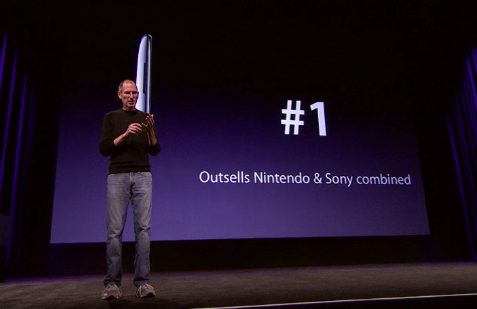At the risk of being like all the other bloggers, I feel the need to write down what I didn’t know or found most interesting about the recent interview with John Sculley, who was the CEO at Apple for about ten years.
First, Sculley made it clear that Apple has always been a digital consumer electronics company, and in many ways was the first such company. As digital components continue to become cheaper and more powerful, thus enabling better consumer electronics, it makes sense that Apple will continue to thrive. Another way of saying this is that Apple was so ahead of its time that even after 25 years the market conditions are only beginning to really align with their strategy.
Second, I often explain to people how Apple’s control of both hardware and software is key to their ability to innovate. There is a lot they simply couldn’t do if they didn’t control the whole pipeline. Sculley recounts an excellent example of this, dating back to the first Mac.
Sculley: The original Mac really had no operating system. People keep saying, “Well why didn’t we license the operating system?” The simple answer is that there wasn’t one. It was all done with lots of tricks with hardware and software. Microprocessors in those days were so weak compared to what we had today. In order to do graphics on a screen you had to consume all of the power of the processor. Then you had to glue chips all around it to enable you to offload other functions. Then you had to put what are called “calls to ROM.” There were 400 calls to ROM, which were all the little subroutines that had to be offloaded into the ROM because there was no way you could run these in real time. All these things were neatly held together. It was totally remarkable that you could deliver a machine when you think the first processor on the Mac was less than three MIPs (Million Instructions Per Second). (NOTE. For comparison, today’s entry-level iMac uses an Intel Core i3 chip, rated at over 40,000 MIPS!)
This approach continues to be important in every category of device Apple produces. For example, today’s iPhones and iPads have special-purpose hardware for video decoding (that’s why they can only play movies encoded in certain formats). Microsoft could not really enter the graphical operating system market until standard processors and graphics cards became powerful enough to do most of the graphics routines themselves. If Microsoft produces an innovative operating system that requires hardware that is too specialized or not readily available, the hardware manufacturers will say, “sorry, we can’t support it.” At Apple, Steve Jobs says, “We will find a way.”
There’s a great little quote about a meeting at Microsoft. “All the technical people are sitting there trying to add their ideas of what ought to be in the design. That’s a recipe for disaster.” Sculley thinks that’s part of the silicon valley culture started by HP, where engineers are most respected. At Apple, designers are on top. “It is only at Apple where design reports directly to the CEO.”
Sculley repeats over and over how good a designer Steve Jobs is. The following story is about a visit to the inventor of the Polaroid camera.
Dr Land had been kicked out of Polaroid. He had his own lab on the Charles River in Cambridge. It was a fascinating afternoon because we were sitting in this big conference room with an empty table. Dr Land and Steve were both looking at the center of the table the whole time they were talking. Dr Land was saying: “I could see what the Polaroid camera should be. It was just as real to me as if it was sitting in front of me before I had ever built one.”
And Steve said: “Yeah, that’s exactly the way I saw the Macintosh.”
Dr Land had been kicked out of Polaroid. He had his own lab on the Charles River in Cambridge. […] We were sitting in this big conference room with an empty table. Dr Land and Steve were both looking at the center of the table the whole time they were talking. Dr Land was saying: “I could see what the Polaroid camera should be. It was just as real to me as if it was sitting in front of me before I had ever built one.”
And Steve said: “Yeah, that’s exactly the way I saw the Macintosh.”
The item which I did not know (or maybe had forgotten) is that Apple’s Newton product played a central role in the creation of the ARM processor design, which is now used across the industry in most smartphones and other consumer electronics (including the iPhone, iPad, and Apple TV). Moreover:
The Newton actually saved Apple from going bankrupt. Most people don’t realize in order to build Newton, we had to build a new generation microprocessor. We joined together with Olivetti and a man named Herman Hauser, who had started Acorn computer over in the U.K. out of Cambridge university. And Herman designed the ARM processor, and Apple and Olivetti funded it. Apple and Olivetti owned 47 percent of the company and Herman owned the rest. It was designed around Newton, around a world where small miniaturized devices with lots of graphics, intensive subroutines and all of that sort of stuff… when Apple got into desperate financial situation, it sold its interest in ARM for $800 million. […] That’s what gave Apple the cash to stay alive.
So while Newton failed as a product, and probably burnt through $100 million, it more than made it up with the ARM processor.
So the product that has become a “celebrated failure” of business school lore was actually one of the most successful products in the industry, when taking the long-term technological view. Not only did it save Apple from bankruptcy, it enabled an entirely new category of power-efficient, mobile computing devices. True, the marketing and business strategy used for the Newton failed. But the underlying technologies and vision not only saved Apple in the 90’s, but also formed the basis of its remarkable growth today.
Everything Apple does fails the first time because it is out on the bleeding edge. Lisa failed before the Mac. The Macintosh laptop failed before the PowerBook. It was not unusual for products to fail. The mistake we made with the Newton was we over-hyped the advertising. We hyped the expectation of what the product could actually [do], so it became a celebrated failure.
Apple has gotten much better at this over time. They are often accused of over-hyping their products, but if you look carefully, Steve Jobs and Apple advertising never claims that their products can do anything they can’t actually do. They say things like “1000 songs in your pocket” and show people dancing to those songs. Some people react with “oh my gosh, that’s what I actually want.” Other people say, “no thanks.”
Technologists complained when Apple described the iPad as “magical.” Obviously the device is not actually magical. But I think that word pretty well describes the actual reaction of many customers to the product.


